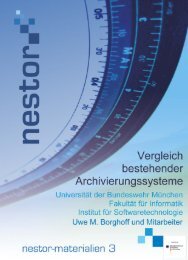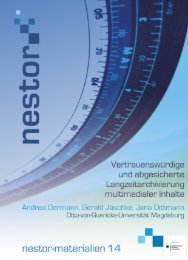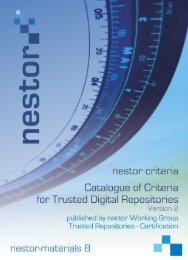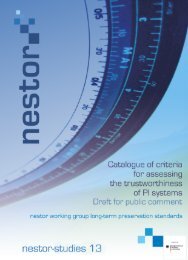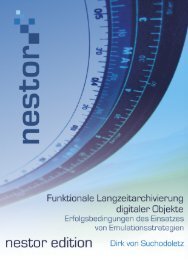Download (PDF, 9MB, Not barrier-free file.) - Nestor
Download (PDF, 9MB, Not barrier-free file.) - Nestor
Download (PDF, 9MB, Not barrier-free file.) - Nestor
- No tags were found...
You also want an ePaper? Increase the reach of your titles
YUMPU automatically turns print PDFs into web optimized ePapers that Google loves.
community. According to the OAIS reference model, the Error Checking function on theone hand draws on (hard- and software related) error logs and on the other depends on“PDI Fixity Information […] [for] assurance that the Content Information has not beenaltered as the AIP is moved and accessed. Similar information is needed to protect thePDI itself” (2002, 4-8). In addition, the bitstreams are protected by the Disaster Recoveryfunction, whichprovides a mechanism for duplicating the digital contents of the archive collection and storingthe duplicate in a physically separate facility. This function is normally accomplished by copyingthe archive contents to some form of removable storage media (e.g., digital linear tape, compactdisc), but may also be performed via hardware transport or network data transfers. The detailsof disaster recovery policies are specified by Administration. (OAIS 2002, 4-8)All three criteria catalogs considered here contain criteria relevant to the ReplaceMedia, Error Checking and Disaster Recovery functions. The nestor and TRAC criteriacatalogs primarily focus on the Replace Media and the Error Checking functional entity,although often these are subsumed under somewhat more general criteria regarding ITinfrastructureand security. In the nestor catalog, the Replace Media function is subsumedunder criterion 8, dealing with the planning of technical long-term preservation measures(see also Preservation Planning below). This criterion, requiring that the “strategic plans(see 4.4) are specified on object level” (nestor 2008, 8; my translation), is fairly broad(subsuming measures for bitstream preservation, protection of authenticity as well asinterpretability), and among others contains requirements concerning the physicalpreservation of the bitstream (uncorrupted bitstreams, refreshment of storage media, etc.).In contrast, TRAC contains a separate criterion exclusively focusing on storage media andhardware change (2007, C1.7). Although DINI does not address the question of hardwarechange explicitly, it requires frequent technical maintenance of the system and itscomponents (see 2007, 2.5.1).The Error Checking function is touched upon in the nestor catalog in criteria 6.2 and7.2, requiring the repository to secure the integrity and authenticity of digital objects duringArchival Storage on the one hand by “specifying procedures which secure the authenticityof the objects during the performance of long-term preservation measures or whichalternatively record the degree of authenticity” (nestor 2008, 7.2; my translation). On theother hand, nestor requires repositories to determine the necessary degree of physicalredundancy in storage (OAIS Disaster Recovery; see also nestor 2008, 10.3), thenecessary quality of storage media, and to regulate logical and physical access to serversin order to secure the integrity of data objects (see nestor 2008, 6.2; see alsoAdministration: Physical Access Control).While the TRAC criteria do not draw a strict terminological distinction betweenauthenticity and integrity, the commentaries to criteria B2.12 and B4.4 evoke bothconcepts. Thus, in particular B4.4 requires repositories to “have Fixity Information for AIPsand [to] make some use of it” (TRAC 2007, B4.4), e.g. by providing and utilizing MD552



